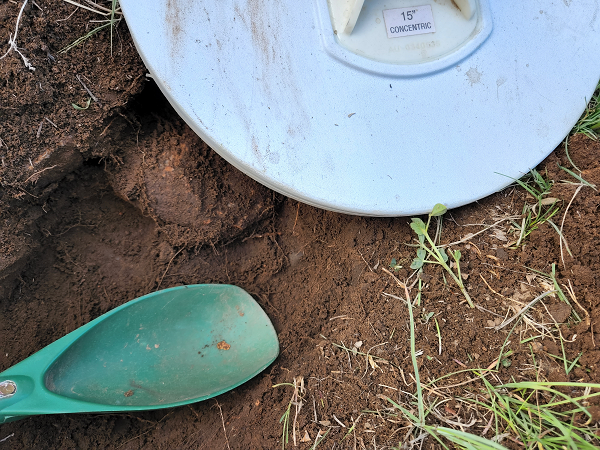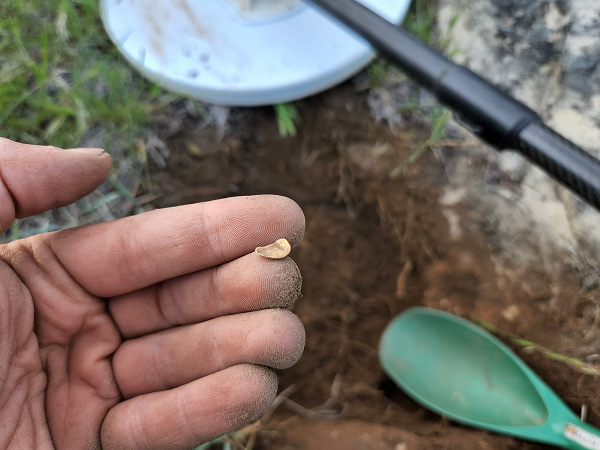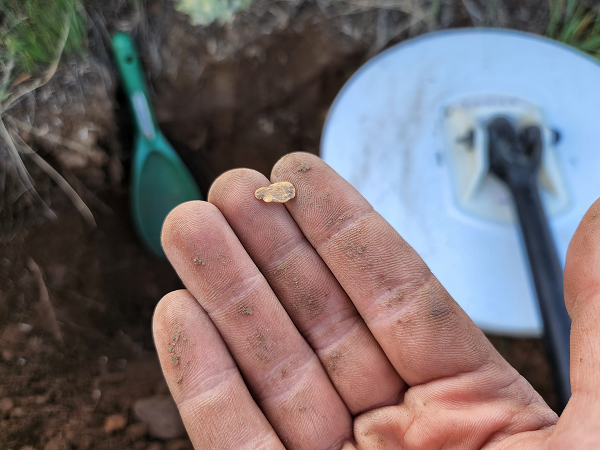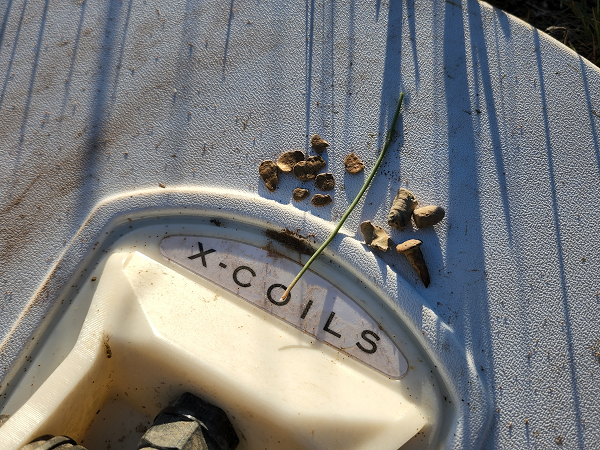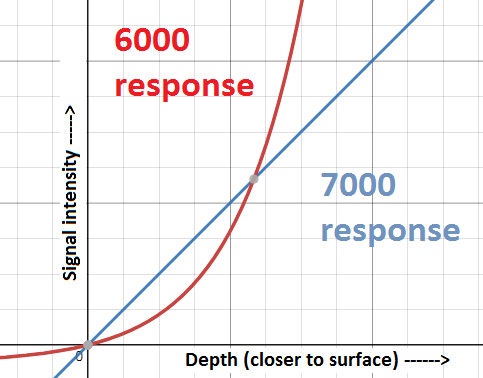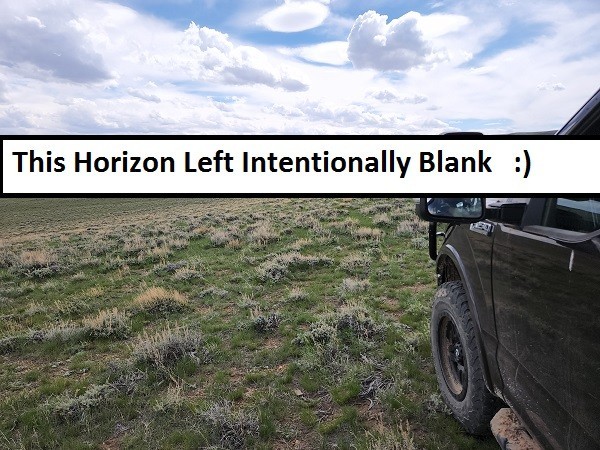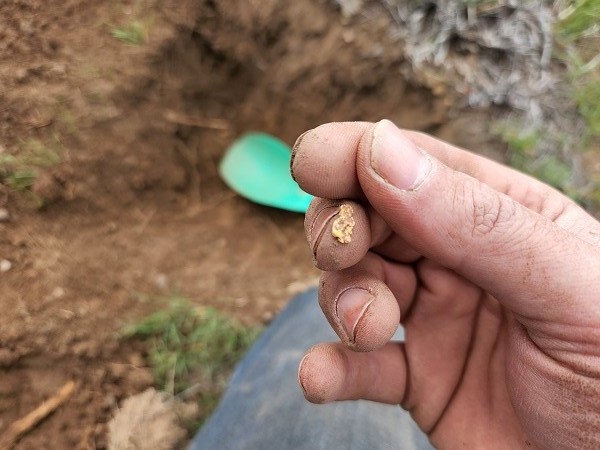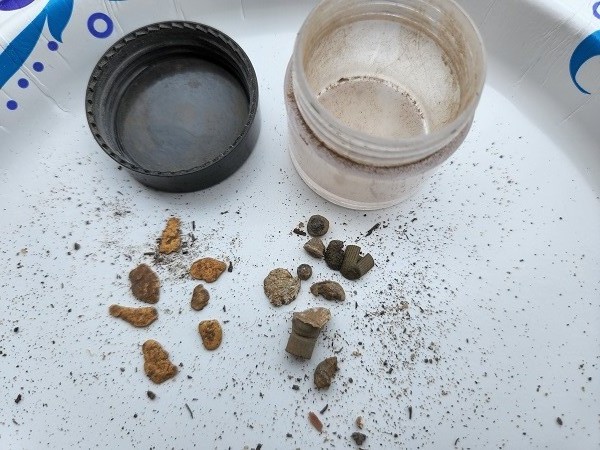-
Posts
2,469 -
Joined
-
Last visited
Content Type
Forums
Detector Prospector Home
Detector Database
Downloads
Everything posted by jasong
-

Running The 15" Cc X Coil Over A 6000 Patch
jasong replied to jasong's topic in Minelab Metal Detectors
There is enough performance gain with these CC's on the GPZ that I'm not even joking when I say Minelab could probably just supply one of these coils with a lighter design 7000 and call it the GPZ 8000 - 40% deeper for $8000, and probably be understating things, based on what I'm seeing. It really makes me wonder what we'll see with the new GPZ whenever it comes out. The bar is high. It absolutely needs to be lighter weight, because it's pretty easy to get a much cheaper big bump in performance with the CC coils right now already. IMO, they need to bring more to the table than just depth and weight too, it needs to deal with salt and mineralization better than the 7000 too, in order to distance itself from what can be done with the buying a 15 or 17" CC on the original GPZ. That all of course assumes we even have a new GPZ in works, which itself is just a total guess based on history. -

Running The 15" Cc X Coil Over A 6000 Patch
jasong replied to jasong's topic in Minelab Metal Detectors
So due to these factors, we should probably expect a bigger performance gain from concentric coils on machines that use these DOD coils stock than we would expect to see on traditional PIs using monos which already have a large RX/TX loop? -

Running The 15" Cc X Coil Over A 6000 Patch
jasong replied to jasong's topic in Minelab Metal Detectors
These are the first concentrics I've used on any detector, so I'm just basically learning about them. I'm curious why they were never very common on the GPX/GP/SD's? A VLF has some ZVT like qualities, are they less effective with true PI detectors? -

Running The 15" Cc X Coil Over A 6000 Patch
jasong replied to jasong's topic in Minelab Metal Detectors
Got out for a bit of exploration on the ATV and 6000 again. More scatter shot prospecting, trying to expand gold bearing zones. Covered a ton of new ground. Unfortunately nothing new turned up. I also brought the skunk buster with me (GPZ + 15" concentric X Coil) so I could end the day with something in my pocket if exploration failed to produce, and decided to run the rest of the sun down by hitting some deep gold bearing ground for a few hours. The 6000 had given no gold in this deeper ground, other than a few nuggets I recovered towards the spot where bedrock started poking out of the dirt towards the periphery. Within a few minutes I hit a small one. It was about 4" deep and I could actually still see my old footprints where I had run the 6000 over this very spot. Quite a loud target on the 15" CC and another one of those targets that left me scratching my head how the 6000 missed it. I was very careful to remove layer by layer so I could know exactly where the nugget was in the hole, it ended up being at the top of the scoop almost under the rock. Keep in mind, this 15"CC X Coil is IMO outperforming the 17" spiral X Coil, which itself is outperforming the ZSearch, which itself is outperforming the stock 14x13 GPZ coil. So it's not like I'm running anything even remotely close to the stock the GPZ here, and if a reader is running stock, they shouldn't expect the same large differences I am seeing. But still, the amount of missed targets I've been finding that seem like they should have been found with the 6000 is pretty exceptional IMO. I worked closer to the edge of the bedrock, but still in the deeper dirt, with my old footprints still visible in a grid. And about 10 minutes later I hit another target, this one virtually screaming. Again I picked down layer by layer with my fingers until I saw the glint of gold so I could see exactly where the nugget was at in the hole. This one was probably 6-7" deep, in some roots. It ended up weighing something around 0.45 grams. A bit more work around the bedrock periphery and I hit on 5 more little nuggets, almost all in the grass roots. I was intentionally ignoring the salt signals (of which there were many), also rejecting any faint or somewhat questionable signals. I was concentrating only on the obvious, strong target signals, of which there seemed to be plenty. It's pretty clear to me now that the 6000 is missing a lot of stuff in this size range below about 5", something good to know so I understand when and where to use the 6000 and how to interpret my results with it. I began the walk back to my ATV, doing a quick swing over some of the ground with no bedrock exposed. I had one final strong signal, this one was down probably 9-10", at the tip of the scoop. It ended up being the heaviest of the day at a whopping 0.57 grams, a bit thicker than the others. So, 8 nuggets (on the left, low light makes the contrast bad) for the short session and 4 bits of trash. All the trash was also 4" or below, the 6000 got all the pellets here. The smallest nugget 0.12 grams and the largest was 0.57 grams. I am in an area where the gold rarely gets above 1 gram. I tried a bit of prospecting, working a little new area on the way back that I had found 1 straggler nugget with the 6000, but it was totally infeasible due to salt. Maybe easy to understand why I was earlier so concerned with determining if larger or concentric coils can be made for the 6000 to give it a little performance boost. I wasn't rabble rousing, it was a serious question that needed an answer. Seeing results like this instantly makes me wonder what a 12" lightweight concentric on the 6000 could have done as far as cutting into missed nuggets goes, while staying light weight. But, seems that is not possible for whatever reasons on the 6000. So, good to know now. And I can only hope that coil manufacturers offer concentric options in the future for detector models that are compatible with them. I'm left curious if CC's offer as much depth gain on PI's, or if they outperform on ZVT tech only, relatively speaking. -

Anyone Familiar W/ The Eureka District, Arizona?
jasong replied to BagdadAz's topic in Detector Prospector Forum
Just as a general idea, there is detectable gold in the wider Bagdad area, if that helps keep the spirits up for a little more exploration closer to home. I've had absolutely horrible and entirely regretable experience sharing specific areas with some people in Arizona, leaving a lot of areas I loved completely and utterly decimated. It's happened to others too, and there are a lot of people highly guarded about discussing areas in Arizona as a result of it. It's a shame because there are some amazing finds in the state that just never get seen at all now because of it all. -

Coiltek Coils For The GPX 6000 - Confirmed!
jasong replied to Coiltek's topic in Detector Prospector Forum
Thanks, the picture is a bit clearer now with some 3rd party evidence, seeing as they can't even sell approved coils and have no horse in the race. After the 7000, it's hard to know exactly what is or isn't possible and what's just marketing at play. Sometimes it feels like pulling teeth trying to cut down to the actual reality of issues with these machines. It's either that or just take it all for face value, which history has shown me is usually wrong when it comes with dealing with corporations. -

Coiltek Coils For The GPX 6000 - Confirmed!
jasong replied to Coiltek's topic in Detector Prospector Forum
I wasn't aware X Coils was making any coils for the 6000 at all until a few days ago when I asked for some kind of comment from them, and you responded. We ask about these things because we aren't mind readers. Maybe I missed something earlier on the forum when I was away for 3 or 4 months regarding sizes? I got told often that there were no issues with 6000 EMI when I posted about it early on. Did that turn out to be the reason bigger coils are infeasible on it out of curiosity? -

Coiltek Coils For The GPX 6000 - Confirmed!
jasong replied to Coiltek's topic in Detector Prospector Forum
(Emphasis mine) The point for me is being able to get rid of the 7000, or at least reduce the cases in which it might need to be used. It's heavy, no fun to swing, and an $8000 purchase that I'd love to sell and recoup some costs from. That detector gave me permanent tennis elbow, I don't want to swing it any more than I have to. A major selling point of the 6000 is ease of use, and lightweight. Not to mention built for coil selection compared to the GPZ. Why wouldn't I want to swing the 6000 instead if I could use a few $400 coils to cut into the 7000's depth advantage? Of course that is going to be one of the first questions I want to ask and figure out. There is no need to get frustrated over people asking what should be expected questions, telling them they are guessing or bitching. The simple fact for me, and I assume it's getting to be the same in Australia too, is that to pay for trips now in the US and maybe make some money on top, I have to still hit up the deep ground and look for the big pieces. 1/4 grammers are great leads to find patches, but they add up slowly. It's a necessity to start farming the 1/4+ oz'ers out after that to make the trip pay, a single 1 oz'er can pay for an entire season's gas (well, used to anyways). Even just getting 5000 depth performance on the 6000 with a few additional $400 coils would be sufficient reason for me to ditch the 7000. As usual, a lot of this could be solved by a little communication from Minelab. Are they about to release a new lightweight GPZ making this whole line of discussion moot? Or are we still years off? Are coil manufacturers in fact allowed to make any range of sizes and types (concentric, flat wound, etc) of coils for the 6000, or is Minelab limiting the types of coils that will be available as they did with the 7000? It should be no mystery why people are asking what they are asking about 6000 coils. We always want to make the most out of what we have now, and get rid of the dead weight to recoup costs. I don't want to use the 7000 now any more than I wanted to keep using my 4500 after it was replaced, if there are cases it can be avoided. -
Dang, sorry to hear they won't be making them. Well, thanks for the update anyways, at least one no longer has to wonder...
-
Crazy, that's an awesome score still even if the big stone isn't real. I always forget about the other parts of the forum until I see a post pop up in the sidebar, and then I'm always utterly amazed at the amount of stuff you guys are finding on beaches...beach detecting is starting to look more fruitful than nugget shooting in some respects! Plus you get a nice cup of coffee paid for in change on your way home.
-
Lack of QC was given or assumed as another reason X Coils couldn't be approved, IIRC. Ironic, given the QC issues with the 6000 now. This last detector release made me realize that I am getting seriously burned out and tired of buying ultra expensive detectors to fill various niches. Especially now that gold is just getting harder to find in paying quantities, at least here in the US. I think I got one more new machine left in me and then I'm done with that game. I love keeping up with technology and being on the cutting edge, I'm that way with everything I do from job to hobby. I'll be ultra stoked and excited on the next GPZ, and probably buy it if it suits me. But it might be my last. I can feel myself just losing interest in the entire Minelab marketing shenanigans in general, it's just old and tiresome to me at this point and cuts into my enthusiasm for products. They are trying to emulate the Apple playbook in some ways, and even Apple with the most rabidly loyal fanbase in the world learned that eventually customers get tired of it, when it becomes clear things are intended more to mine their wallets than to provide awesome new features and usability that users are asking for. This type of product segmentation, requiring customers to only use "corporate approved" crap, this is not what made companies like Apple great, it's what made loyal customers start to get tired with or even angry with them, and Minelab is starting to fall into that category to me. All that aside, I'm actually pretty content right now with the 11" mono myself, it is what it is and I'd certainly use something better if it was available, but just the weight and usability is enough for me at the moment since I really want a break from the GPZ. I'd take a smaller coil to save some more weight, I don't particularly need it though. I'd definitely take a concentric, flat wound, or other coil that gives me greater performance with a lighter weight, of any size, if it can cut into the 7000's territory a bit more. If any manufacturer wants to make such a thing, or if it's possible. But, there is nothing interesting to me about just simply a smaller coil just based on size, if it doesn't at least perform better in some way.
-
The part I'm curious about is wether they can squeeze more performance out when it's thought impossible, or if there really are hardline limitions with coil designs on the 6000 and the existing coils are already up against them. It was said you couldn't do this or that with 7000 coils because of over saturation, inability to balance in many soils, etc. But they found a way. Is it the same with the 6000? I never personally saw any issues that required me to use the ferrite ring with any GPZ coil, including stock. Nor did I ever see any issues with the X Coils failing to balance, aside from a few quirks in some very specific areas. So, it seems like a silly limitation to require all coils to be designed for global users such that they operate ok in difficult soils that I (and many others) will never detect in our lifetimes. My wish list ultimately would to be able to have coils for the 6000 that let me get rid of my 7000. If such a thing is possible. Because I'm pretty tired of the boat anchor. Whatever those coils may be that get me closer to that goal, even if it just means using the GPZ less than I already do, then I'm all for it.
-

Coiltek Coils For The GPX 6000 - Confirmed!
jasong replied to Coiltek's topic in Detector Prospector Forum
Not selling your 6000 anymore then? I see indications that the rigid control over coils and the range of sizes available is less about Minelab adding another revenue stream (how much can you actually make off a chip license compared to a new detector sale?) and more to ensure there is a solid delineation between detector models in performance, so as to ensure we'll always be eager for newer detector models at $6-10k rather than just buying much cheaper coils to enhance performance. -
Depth isn't as important as you might be thinking it is. If you are in mostly undetected country, then most of the gold within reach of a 7000 is also still within reach of a 6000. The two are separated in terms of inches, or less depending on the coils and nuggets. What is most important at your experience level is learning to find good gold first, and the 6000 is built for that type of exploration. In steep, vegetated terrain, the GPZ is very difficult to use. And the 19" coil isn't a whole lot deeper, but is a whole lot heavier. It's the last coil I'd ever consider using up in the mountains, in fact I'd never use it for anything personally. Also: in highly uneven mountainous terrain, or working cuts and steeps, the bungee/harness doesn't help much at all. The 6000 is purpose built for working steeps, finding patches, and general exploration. The 7000 is built for getting another few inches depth in patches you've already found, or other known ground where you suspect the gold is hiding inches beyond what the 6000 can hear. In glacial terrain the depth of the detector isn't nearly as important as learning to find shallower ground. Glaciers leave gold so chaotically distributed that prospecting skill is far more valuable than having the best detector, and IMO the 6000 is the best detector by far to explore with and develop such a skillset.
-

Coiltek Coils For The GPX 6000 - Confirmed!
jasong replied to Coiltek's topic in Detector Prospector Forum
I wish the X Coils guys posted some update on the forum, I'm pretty curious what they think about wether or not the 6000 is suitable for flat windings, concentrics, etc and wether they can make some coils that have actual performance gains and not just size selections. -
Nice gold Geoff and I agree with the wording too. If I already owned a GM1000 and wanted to buy just one single detector to use in the Rockies, it'd be the 6000. Just be ready to noise cancel it often if you use the speaker or work close to EMI sources. The 7000 was an absolute bear to use in Colorado the one day I tried (I dislocated my shoulder falling after trying to detect a steep incline, so trip ended), and having also been to BC, things are just as steep and even more vegetated up there. It's been long enough since the 7000 release that a new one must be on the horizon soon so it's not really a machine I'd recommend anyone to buy right now really until we see what the next one costs and how it performs.
-

Coiltek Coils For The GPX 6000 - Confirmed!
jasong replied to Coiltek's topic in Detector Prospector Forum
What are the prices in USD for these Rob? I'm assuming the ones on the prior page are in AUD? -
Steel bearings are made with much tighter tolerances than lead pellets since they have to roll true, if you guys are looking to normalize geometry. Maybe a more consistent alloy too since they are made from rolls of wire and there is less variance in stainless steel than there is in shotgun pellet alloys. Kits like these are cheap. Of course the response to steel is different than to lead and gold, but it might not matter if the main goal is just to have a standard baseline object that anyone across the world can test and replicate.
-

Running The 15" Cc X Coil Over A 6000 Patch
jasong replied to jasong's topic in Minelab Metal Detectors
Targets on the 6000 seem to go from "not there" to "good target" fairly quickly on the 6000. Wheras the 7000 seems to have much more nuance with the faint signals, they increase in intensity slower, not all at once like the 6000 likes to do. This quirk can be useful since it's much quicker to chase and dig the signals above the intercept point with the 6000, and much quicker to chase the fainter, more nuanced once with the 7000 below the intercept point. At least, IMO. It's like the 6000 has an exponential target response and the 7000 is more linear. At something like this is how it feels in my head: -

Running The 15" Cc X Coil Over A 6000 Patch
jasong replied to jasong's topic in Minelab Metal Detectors
It'd be interesting to give a concentric a run on the 6000. I wonder if NF and/or Coiltek tried to make one, they are notably missing from their lineup but it's early still... I seem to recall seeing something about X Coils already had some sort of coil out in testing for the 6000 already, I'm guessing they will make one if it provides some measurable advantage. 2 adapters required on the 6000 though right? DD chipped adapter for concentric and the monos would require a separate mono chipped adapter? Also, not trying to be overly pedantic but "CC coil" is like saying "PIN number". The coil is already in there. Ok sorry. -

Running The 15" Cc X Coil Over A 6000 Patch
jasong replied to jasong's topic in Minelab Metal Detectors
I'll try the 12" test this summer when winds die down. I couldn't even get a final nugget shot sitting on the coil at the end of the day without the wind blowing the nuggets off! The pic i got on my finger was early when i got there before the tornado force winds came in for the rest of the day. Other places the wind would blow dirt and everything right out of the scoop unless I shielded it with my body. 😆 Haha yep that is kinda a drumstick looking nugget too. I'm always real bad at seeing resemblances, they all look like shape 1 or shape 2 to me until someone points something out. -

Running The 15" Cc X Coil Over A 6000 Patch
jasong replied to jasong's topic in Minelab Metal Detectors
Also: my transmission went out in my warrantied Ford. Ford said "parts shortage" prevented them from supplying customers with replacement transmissions, which is total BS because they have thousands of F150's and F250's stacked in the Kentucky Motor Speedway parking lot with transmissions in them and they are still selling new trucks. They were saying it might be 4 months to 1 year to get my truck fixed and that my only solution was to buy a brand new truck, which I had literally just done. Totally unacceptable. You'll note I have my F150 back. The day I decided to contact my attorney and forward Ford copies of relevant federal warranty laws and how they were in voilation, all of a suddent the "parts shortage" ended and I got one sent to me. Companies are starting to use this crap as excuses for their own mismanagement and to do less for their customers IMO. Anyways, just letting people know who might find themselves in a similar situation with truck warranties in the US. We have laws protecting the agreements manufacturers made with us when we paid for what we bought and fulfilled our part of the agreement. If they offshored their entire manufacturing to make shareholders a bit more profit, we aren't the ones that have to pay for it, they are. -
General Summary: I set out with two goals in mind, but only accomplished one. I wanted to compare the 6000 response on small nuggets to the 12" X Coil, but this was completely pointless due to the 30mph winds making audio on my cell phone completely inaudible. Also, I wanted to try out the 15" CC X Coil I was sent last year but simply have not had a chance to try out due to a number of factors in life. X Coils sent this coil to me for free to try out right as my detecting season had ended last year. I worked over about a 20x50ft section of a patch completely with the 6000 until there were no audible targets left. I use Auto+ in normal. Then, as is my general technique, I set the GPZ such that I was running the maximum gain with the most stable threshold I could acquire. In this case, 18 gain, 12 threshold, low smoothing, normal. My feeling is that these settings average out to something fairly close to what the 6000 is doing in Auto+, if any equivalency can be drawn, ignoring GeoSense. Almost every target was 6+ inches deep with the CC. Whereas most of my 6000 targets were about 1-7" deep. Nothing too surprising here. Initially from this section I got about 40 nuggets with the 6000, and got another 7 more with the CC. The avg size of the 6000 nuggets was around 0.1 grams, and the average size of the deeper CC nuggets was around 0.25 grams. There is both salt and medium mineralization in this ground, and the CC suffered as would any larger coil in the salt. I'm quite sure I left some nuggets in the ground because I got tired of chasing salt signals. The 6000 w/11" pretty much only gave a signal on targets or the buried clay balls and so it was much easier to dig only just good targets. But it definitely missed stuff once it got deeper than 5-6" or so. Here you can see a pretty typical ~7" hole that the CC was finding gold in. This gold looks bigger but it only weighs 0.21 grams. I think the deepest one I dug was around 9". The gold here doesn't often get bigger than 3/4 gram, so physics limits the depth at which this stuff can be found, thus the lack of deeper results. My gold vs trash take. Almost everything was 6"+ deep, including trash. The 6000 got almost everything closer to surface aside from the one smallest pellet. I say almost everything 6" deep because the longer nugget was only like 2" deep and there is no way the 6000 missed that thing. Again, I swear the 6000 is occasionally "hiccuping" and missing some quite obvious targets. I don't know if it's due to electronics bogging down/glitching, or just needing to hit some nuggets exactly the right way and in the right direction. But that one was almost an overload signal on the Z. But maybe I just didn't overlap swings enough...no clue. The gold vs trash ratio is pretty similar to what I got closer to the surface with the 6000. A lot of this surface soil is deflationary, meaning gold is often found right in the grass roots up top, depending how heavy the wind is and how much ground cover there is. My Opinions: Having used the 17" CC earlier in Arizona, I already knew these coils were killer. Seriously, they are like having a GPZ 7500 before anyone else, and I'm not just saying that because I got the coil for free. They are that much deeper. Anyone who has an X Coil adapter already, and who hunts in ground where deeper nuggets have been proven to lurk - this coil will almost certainly find you more gold (as long as the gold is actually there). That said, like any larger coil, they suffer in salt. So this test wasn't quite an apples to apples comparison. And actually, I didn't even fully realize there was salt in the ground here when I was running just the 6000, otherwise I'd have chosen a different spot. But the salt signal was definitely there and obvious when swinging across soil interfaces. Also, I recall reading that these CC's are way better in mineralization than the spirals, which may be the case (I haven't tested), but the 6000 had far less overall response to the iron mineralization than the GPZ+CC, even though larger coils are better with ferrite type mineralization, generally speaking. This is more a function of the GPZ than the coil though, I believe, in this case since the 17" I ran in Arizona didn't suffer any more than the stock GPZ coil in medium mineralization. In summary, I'll end with something I've said before: these CC's (and the 8" in salt) are the only reason I'm still hanging on to my GPZ still. I'd have sold it long ago if these coils didn't exist. They are seriously like having a new GPZ that no one else has access too. That said, nothing - and I mean nothing - can compete with the ease of use of the 6000, and it's quickness and speed. It's built to be a prospecting machine, not a patch cleaner. Yes. It misses stuff. Absolutely, without doubt. And if a person is primarily spending time cleaning up the last remaining crumbs in long dead patches then the 6000 is not a great choice and nothing can compete with the depth and sensitivity of the 7000+ X Coils. But for general prospecting and exploration, nothing on the market can compete with the 6000 either. Two separate machines, two separate use cases. My arm was dead tired after swinging the GPZ again, I only made it 6 hours and normally I like to spend 10 hours if I'm making a trip to the field. And I just have to swing far, far slower with the GPZ both due to the increased ground response and the outright weight of the coil/machine. And in the end, I actually found more nuggets by number and weight with the 6000 just by accepting that I would lose some gold left behind and being ok with trading that for raw speed and ground coverage. I wasn't sure how much gold I left, but I knew I left some. It paid for my gas and back, so not insignificant. And if one of those deeper nuggets was a lunker, well then it might pay for an entire season of gas, never know. But my personal detecting philosophy is to sweep up 80% of the easy stuff quickly and move on to find more places. It just pays better over time. Then come back with the GPZ + X Coils to clean up patches when times are lean and exploration isn't paying off, or when my arm and elbow feel up to the task. This is the reason I'm using the 6000 so much now. And it's also the reason I'm still keeping the GPZ. But of course we all use detectors for different things, and this is just me showing how each works well in their own specific use cases which might not apply to anyone else.
-
Nice, I liked that one too. Seemed like it ended too early, looking forward to this special!
-

Need Help Identifying Statue
jasong replied to Jarnold9223's topic in Rocks, Minerals, Gems & Geology
It's meant to look like the ancient Chinese white jade figurines, don't think it is authentic though. Stuff like these were sometimes recovered from tombs and the lore states that they soaked up blood and got a brownish or reddish tint from that. At least, I know a girl in China who's father collects this stuff and resells it, and this is more or less what I recall her telling me they believe. That one has what appears to be modern saw marks on the bottom and it looks like the blank was cut from a modern core bit. So I'd guess not an artifact. But it might be some low grade white jade with many impurities, or some jade-like mineral amalgamation with orthoclase, zoisite, stuff like that if the reproduction was higher quality. Might take it to a Chinese antiquities dealer just out of curiosity though, the real ones are quite valuable, and I'm no expert by any means.



